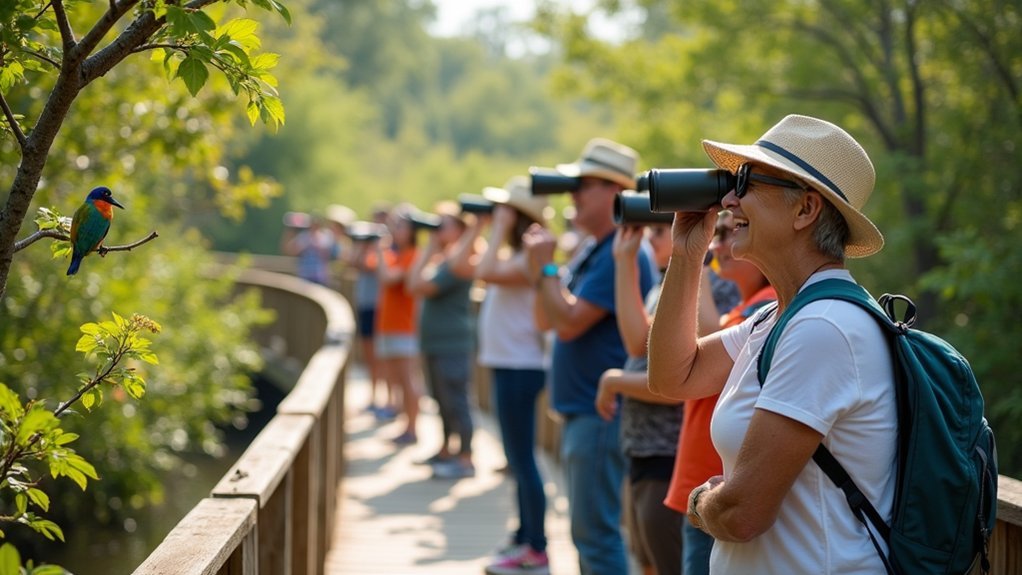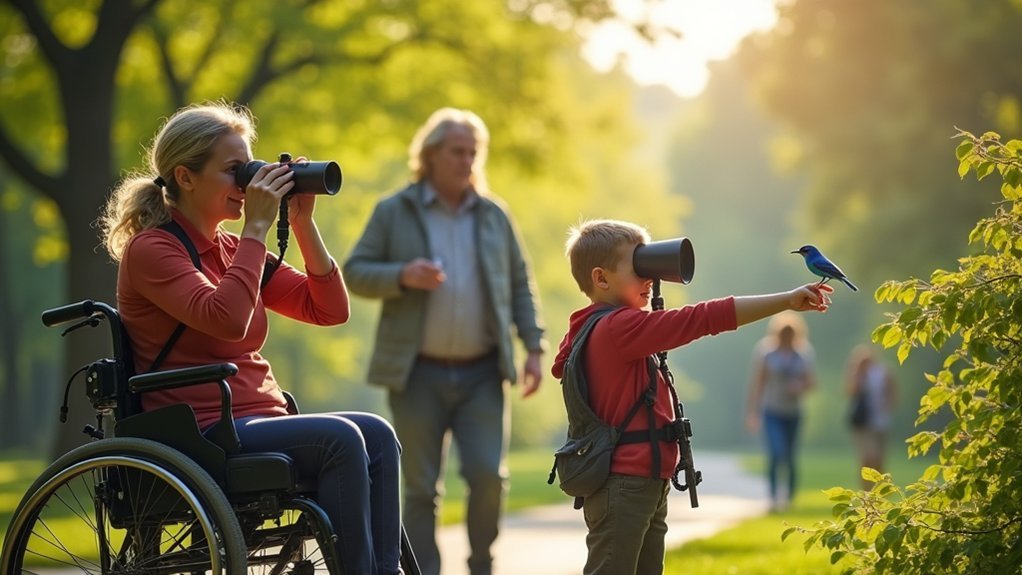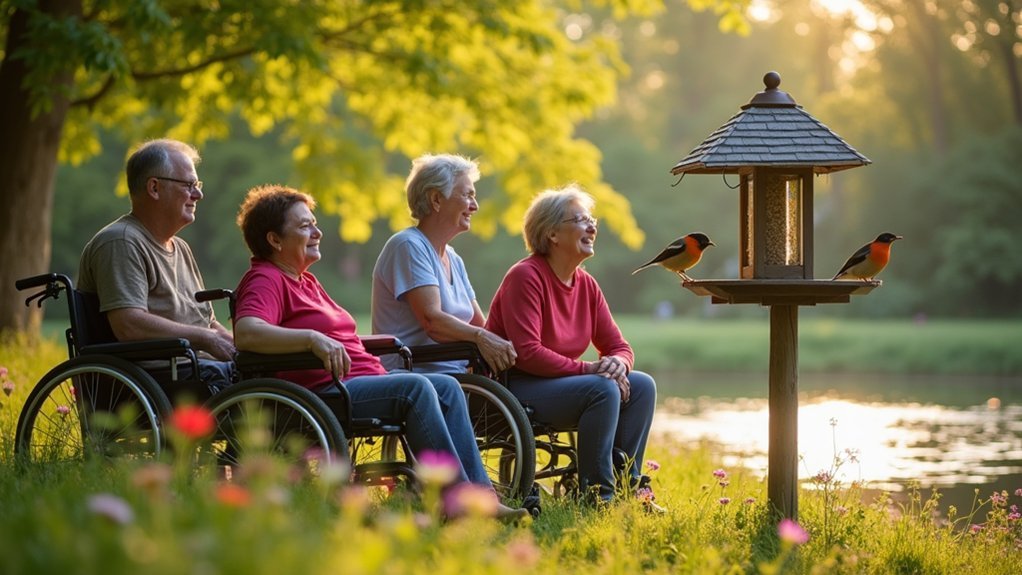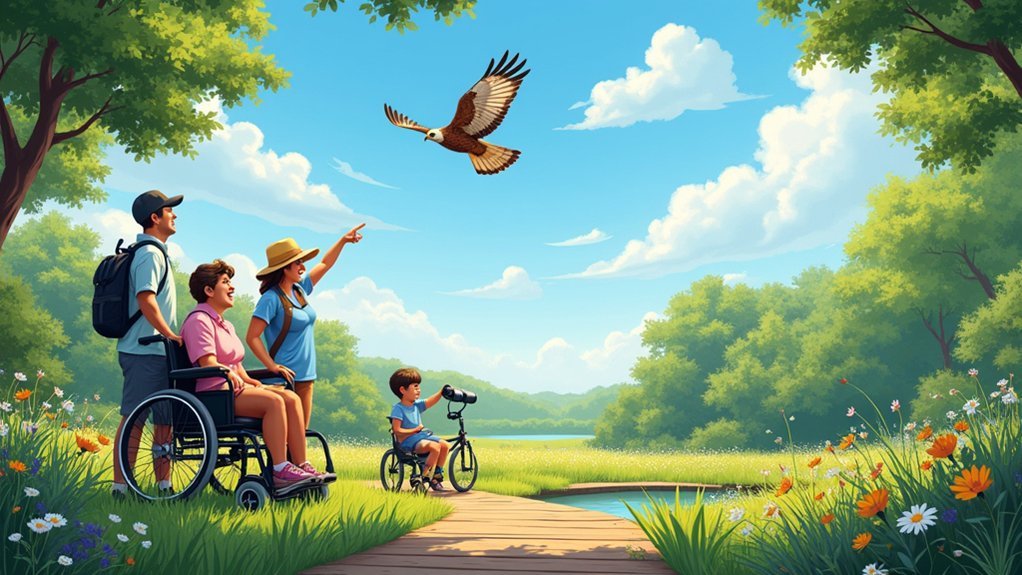Mobility-friendly birdwatching creates truly inclusive outdoor experiences that benefit everyone. You’ll find that accessible trails, adaptive equipment, and community bird walks remove barriers for people with disabilities while enhancing everyone’s connection to nature. Whether you use a wheelchair or have no mobility issues, these accommodations make spotting feathered friends more comfortable and enjoyable. The mental health benefits and social connections formed during these outings extend far beyond the initial thrill of wildlife observation.
The Universal Appeal of Feathered Friends

While many outdoor activities require specialized equipment or peak physical condition, birdwatching welcomes everyone with open arms. As America’s most popular outdoor activity, birding transcends physical limitations and backgrounds, offering a genuine connection to nature that’s universally accessible.
You don’t need to climb mountains or run marathons to experience the joy of spotting a vibrant cardinal or hearing a mockingbird’s song. Organizations like Birdability champion this inclusivity, recognizing that one in four U.S. adults lives with a disability. Their efforts guarantee that accessibility isn’t an afterthought but central to the birding experience.
When trails, viewing platforms, and birding locations accommodate all mobility needs, everyone benefits from nature’s winged wonders—regardless of physical ability.
Breaking Down Physical Barriers in Nature
You’ll find more parks and nature areas implementing universal trail designs with paved, smooth paths that accommodate wheelchairs, walkers, and strollers.
Equipment adaptations like phone-compatible monoculars, lightweight binoculars, and camera mounts for mobility devices have revolutionized how people with physical limitations experience birdwatching.
These accessibility improvements, along with resources like the Birdability Map, are transforming birdwatching into a truly inclusive outdoor activity where everyone can appreciate the wonder of birds.
Universal Trail Design
Although many natural areas remain inaccessible to people with mobility challenges, universal trail design is transforming the birdwatching landscape. You’ll find that wheelchair-friendly paths with smooth surfaces enable everyone to participate in inclusive birding experiences, regardless of physical ability.
| Design Feature | Benefit | Impact |
|---|---|---|
| Paved surfaces | Wheelchair navigation | Increases participation |
| Rest areas/benches | Reduces fatigue | Extends birding duration |
| Clear signage | Improves navigation | Enhances independence |
When you visit accessible trails, you’ll notice thoughtful elements like wider paths and strategic rest points that accommodate all mobility levels. The Birdability Map helps you locate these inclusive spaces before you travel, rating locations based on accessibility criteria. These design principles don’t just remove barriers—they actively promote mental and physical wellbeing by ensuring everyone can connect with nature.
Equipment Adaptations
Beyond thoughtful trail design, specialized equipment adaptations enable even greater access to nature’s wonders for mobility-challenged birders. Lightweight wheelchairs and mobility scooters transform previously inaccessible terrain into navigable pathways, opening up diverse habitats for exploration.
You’ll find valuable resources like the Birdability Map and Birding on Wheels directories that identify wheelchair accessible locations with specific features tailored to your needs. These tools highlight venues with paved paths and adequate resting areas, taking the guesswork out of planning your next birding adventure.
The right equipment does more than overcome mobility challenges—it fosters independence and connection. When paired with simple site modifications like strategically placed benches and accessible facilities, adaptive equipment creates an inclusive environment where you can focus on the birds rather than barriers.
Adaptive Equipment That Transforms Birdwatching

While traditional birdwatching often demands standing for extended periods and carrying heavy equipment, innovative adaptive gear has revolutionized the hobby for those with mobility challenges.
You’ll find lightweight, portable chairs and specialized binocular harnesses that prevent fatigue during extended viewing sessions, addressing common accessibility challenges.
Wheelchair-accessible birding has advanced considerably with specialized scopes that mount directly onto wheelchairs, providing stability without physical strain.
Specialized wheelchair-mounted scopes enable strain-free birding, bringing stability and freedom to mobility-challenged enthusiasts.
Organizations like Birding on Wheels and Birdability offer valuable resources to help you identify suitable adaptive equipment and accessible locations featuring wide paths, ramps, and viewing platforms.
These modifications guarantee that everyone, regardless of mobility limitations, can experience the joy of spotting that elusive warbler or majestic hawk.
The right adaptive equipment doesn’t just make birdwatching possible—it makes it comfortable and enjoyable.
Community Connection Through Accessible Bird Walks
As you join an accessible bird walk, you’ll quickly discover that these outings offer far more than just wildlife observation. Organizations like Birdability are fostering community connections by making birding locations available to everyone, regardless of mobility challenges.
The success of these walks is evident—one group of 15 people with varying mobility needs spotted about 20 bird species on a paved trail. The Birdability Map helps you find rated locations based on accessibility features.
- Find welcoming communities where “birding is for everyone” isn’t just a slogan
- Connect with diverse participants who share your passion for nature
- Access crowdsourced information about trail conditions before you arrive
- Experience the sense of belonging that comes from inclusive outdoor activities
Clear communication about accessibility guarantees you’ll have realistic expectations and feel fully included.
Mental Health Benefits of Inclusive Outdoor Experiences

When you immerse yourself in mobility-friendly birdwatching, you’re tapping into nature’s proven healing properties that reduce stress and improve cognitive function.
Connecting with fellow birders in inclusive outdoor settings fosters valuable social bonds that combat isolation and build community support networks.
Focusing on the movements and calls of birds encourages mindfulness, allowing you to remain present in the moment while developing emotional resilience that extends beyond your time in nature.
Nature’s Healing Properties
Though often overlooked in traditional healthcare discussions, nature offers powerful therapeutic benefits that can transform mental health outcomes for people with mobility challenges. When you immerse yourself in natural settings through inclusive birdwatching, you’re accessing a powerful mental health resource.
Birdability and similar initiatives recognize that all birders, including those with disabilities, deserve equal access to nature’s healing properties.
- You’ll experience reduced anxiety and depression symptoms through regular nature exposure
- You’ll build meaningful community connections that combat isolation
- You’ll gain emotional resilience through shared outdoor experiences
- You’ll develop a sense of accomplishment and empowerment through overcoming accessibility barriers
These benefits aren’t luxuries—they’re essential components of holistic well-being that everyone deserves to access, regardless of mobility limitations.
Social Connection Outdoors
Nature’s healing properties extend beyond individual experiences into meaningful social bonds. When you participate in accessible birding activities, you’re not just spotting birds—you’re building community.
These wheelchair accessible outdoor experiences combat isolation, particularly beneficial for those with mobility challenges who might otherwise miss opportunities for social interaction. Organizations like Birdability create spaces where diverse groups can connect while enjoying nature’s wonders together.
You’ll find that these shared experiences foster a sense of belonging and support mental wellbeing in profound ways. The social aspects of mobility-friendly birdwatching contribute notably to participants’ self-esteem and confidence.
As you navigate trails alongside others with similar interests, you’ll develop independence and form friendships that extend beyond the birding experience—creating a supportive network that enhances overall quality of life.
Mindfulness Through Birding
Immersing yourself in birdwatching creates a natural pathway to mindfulness and mental clarity. When you’re focused on spotting a warbler or listening for a chickadee’s call, your mind naturally shifts away from daily stressors.
Many wheelchair users report that accessible birding spots provide essential mental health benefits they couldn’t find elsewhere.
- You’ll experience reduced anxiety levels as you connect with nature in the present moment
- Your mood improves markedly when regularly visiting accessible birding locations
- You’ll develop enhanced emotional resilience through mindfulness through birding
- You can practice natural self-care as you observe wildlife, regardless of mobility limitations
Since connecting with nature through birdwatching helps combat feelings of isolation while promoting mindfulness, accessible birding opportunities aren’t just nice-to-have—they’re essential for everyone’s wellbeing.
Designing Trails That Welcome All Bird Enthusiasts
When passionate birders envision the perfect outing, access shouldn’t determine who gets to participate. Paved paths in parks and neighborhoods greatly improve accessibility for those with mobility challenges, creating inclusive experiences for all bird enthusiasts.
The Birdability Map serves as an invaluable resource, offering detailed accessibility information about over 1,000 birding locations. It rates sites based on trail surface, width, gradient, and restroom availability—helping you plan your adventures with confidence.
Discover accessible birding sanctuaries in advance with detailed ratings on every feature that matters for your mobility needs.
You’ll find organizations like Birding on Wheels providing directories of wheelchair-accessible locations.
Even simple additions like strategically placed benches along trails can transform the experience for many visitors.
Continuous assessment of existing trails guarantees they meet accessibility standards, acknowledging that when we design inclusive spaces, everyone benefits.
Success Stories: How Mobility-Friendly Birding Changes Lives
Behind every accessible trail and thoughtfully designed bird blind lies a powerful story of transformation and renewed purpose. Virginia Rose’s journey exemplifies how accessible birding can empower those with mobility challenges to reconnect with nature after life-altering events.
When you participate in Birdability’s monthly outings, you’ll witness firsthand how inclusive birding communities foster healing:
- Participants regain physical strength and confidence traversing outdoor spaces
- The Birdability Map connects you to over 1,000 accessible locations tailored to your specific needs
- Shared experiences create bonds that combat isolation often faced by those with disabilities
- Nature engagement greatly improves mental health and overall quality of life
These success stories demonstrate why inclusive birding initiatives aren’t just nice-to-have—they’re essential for ensuring everyone can experience the joy of birdwatching.
Advocacy Tips for Better Accessibility in Natural Areas
Although many natural areas remain challenging for mobility-restricted birders to navigate, effective advocacy can transform these spaces into inclusive environments where everyone can enjoy wildlife.
You can start by encouraging local parks to implement paved, smooth trails essential for wheelchair users. Use accessibility checklists when meeting with park management to assess facilities like benches, restrooms, and pathways.
Partner with the organization Birdability to leverage their map of accessibility-rated birding sites. This resource helps identify where improvements are needed most.
Encourage local birding clubs to host welcoming and inclusive outings specifically designed for people with mobility challenges. Share your personal experiences to highlight barriers—these stories often inspire meaningful change more effectively than statistics alone.
Your advocacy creates natural spaces everyone can enjoy.
Future Innovations in Inclusive Wildlife Observation
The landscape of accessible birdwatching continues to evolve with promising technological and infrastructure developments on the horizon.
You’ll soon benefit from resources like the Birdability Map, which already catalogs over 1,000 sites with accessibility ratings across the U.S.
Community-driven initiatives are transforming your birdwatching experience:
- App-based accessibility checklists letting you evaluate trail conditions before your visit
- Birding on Wheels directories highlighting wheelchair-accessible locations nationwide
- Collaborative projects with the National Audubon Society creating thorough accessibility guidelines
- Strategic modifications to existing sites, including additional seating and improved circulation space
These innovations aren’t just conveniences—they’re essential steps toward ensuring everyone can experience the joy of wildlife observation, regardless of mobility challenges.
Frequently Asked Questions
What Are the 5 S’s of Birding?
When you’re birding, remember the 5 S’s: Sight for observation, Sound for bird calls, Space for movement, Support for inclusivity resources, and Safety to guarantee hazard-free environments. They’ll enhance your birdwatching experience.
How Can Bird Watching Benefit People in the Local Community?
Birdwatching benefits your community by fostering social connections, improving mental health, encouraging outdoor activity, building shared ecological awareness, and creating inclusive experiences that unite people of all abilities and backgrounds.
Why Is Being Patient Important While Bird Watching?
Patience is vital during birdwatching because you’ll miss wildlife if you rush. You’re more likely to spot diverse species when you’re still and quiet, allowing birds to reveal themselves on their own terms.
What Is the Psychology of Bird Watching?
Birdwatching’s psychology benefits you through stress reduction, mindfulness, and cognitive stimulation. You’ll experience improved mental health as you connect with nature, enhance your attention skills, and find joy in each new discovery.
In Summary
You’re part of a revolution that’s making nature’s wonders accessible to everyone. By supporting mobility-friendly birdwatching, you’re not just helping those with physical limitations—you’re enriching our entire community. Whether you’re advocating for better trails or sharing adaptive equipment tips, your efforts matter. Remember, when we remove barriers to experiencing birds, we’re creating a more inclusive world where everyone can enjoy the healing power of nature.





Leave a Reply